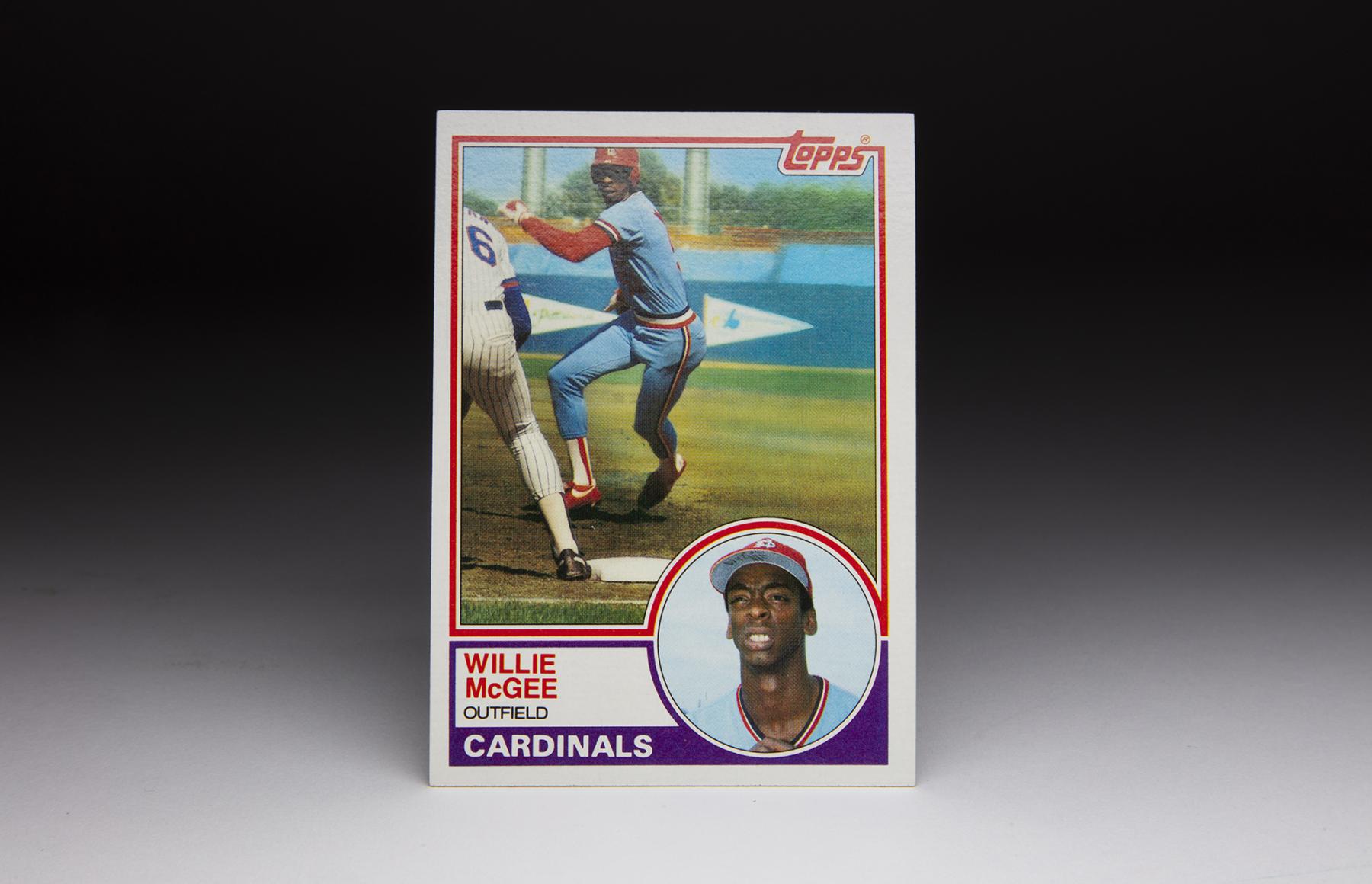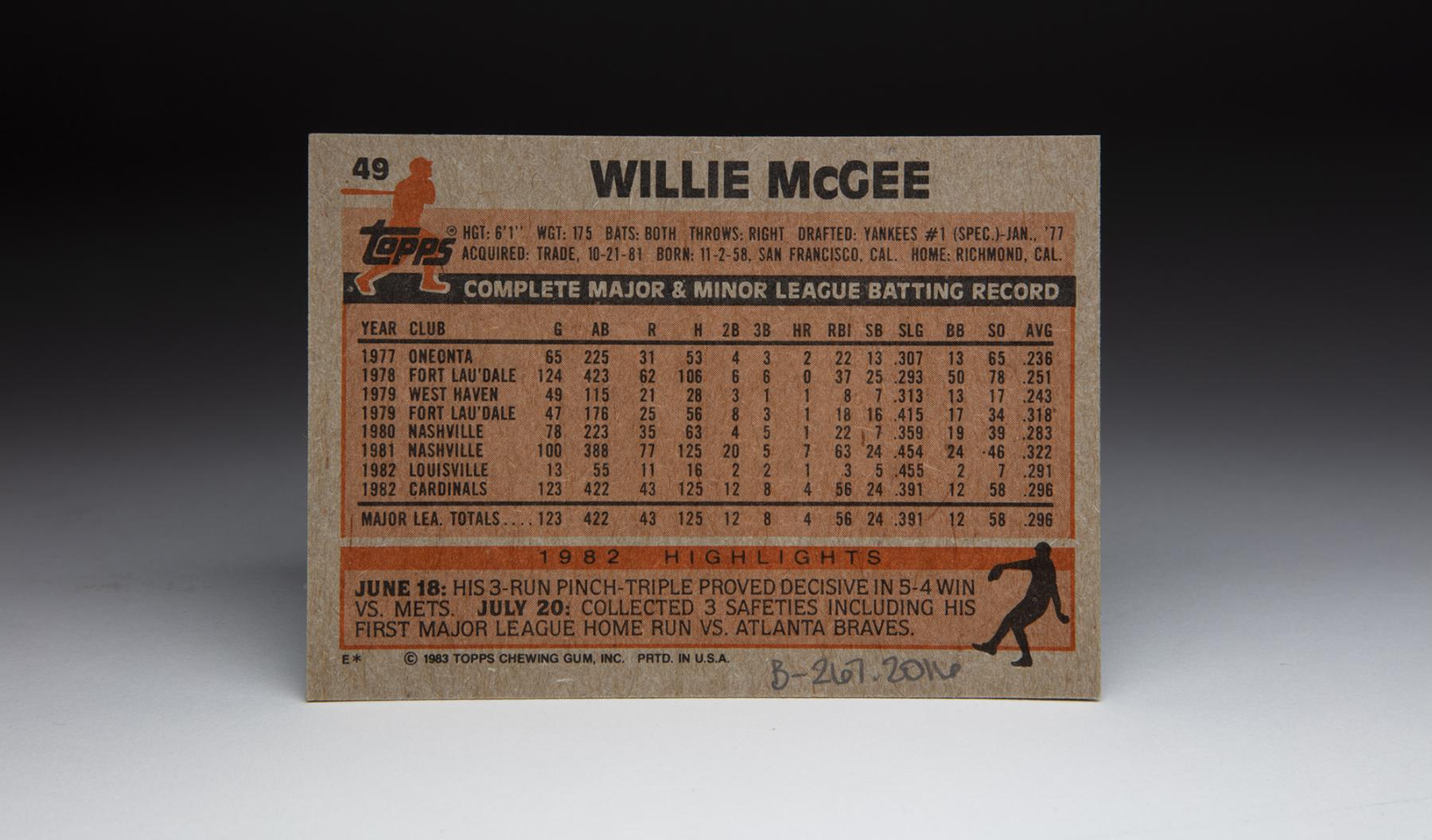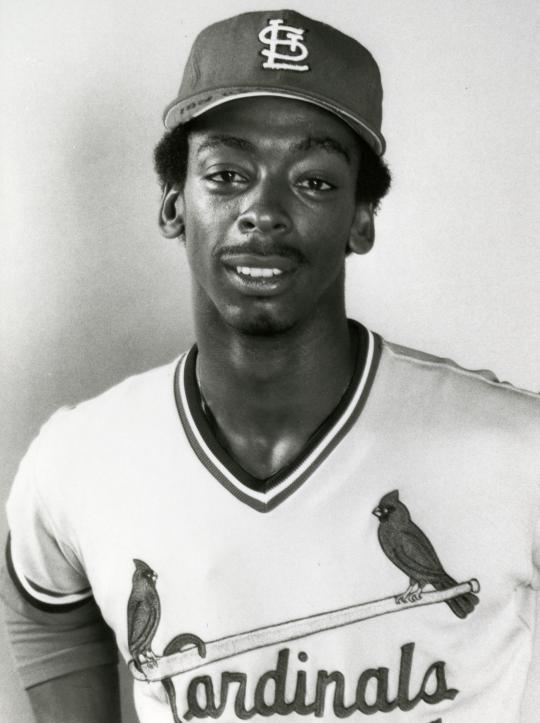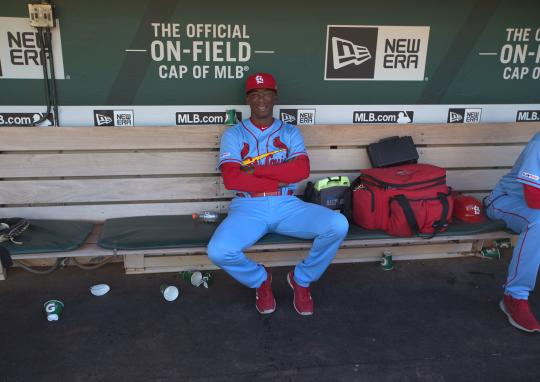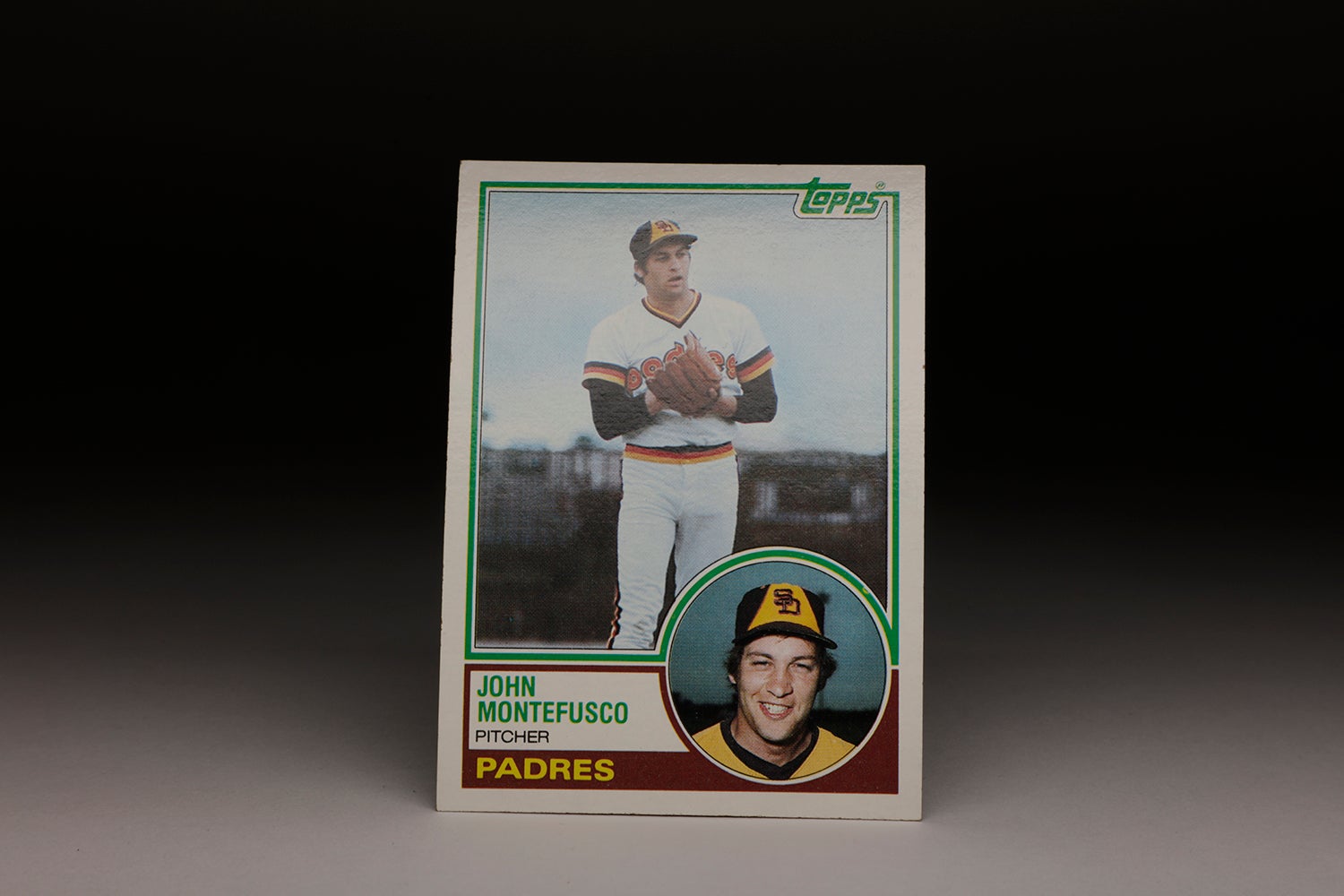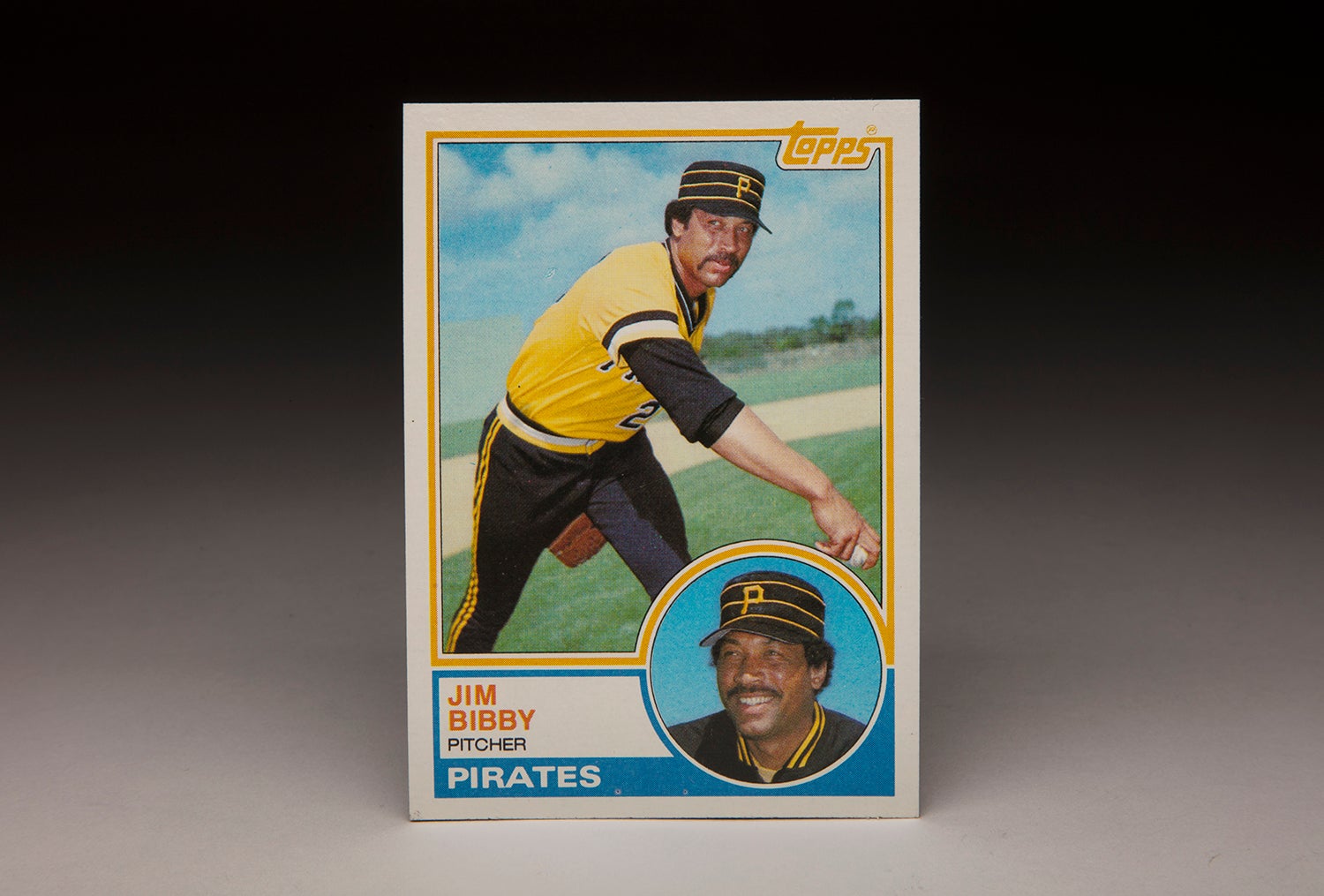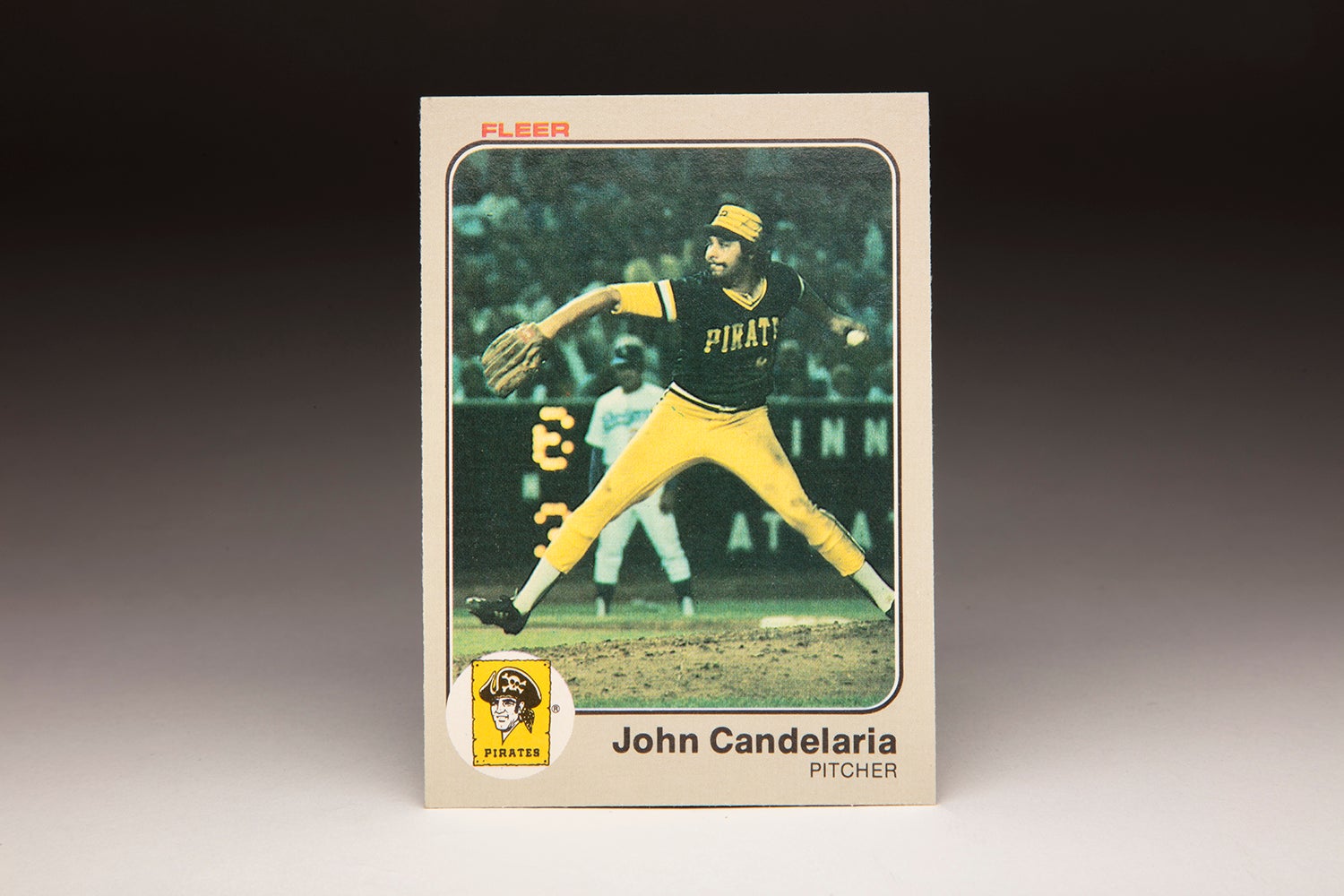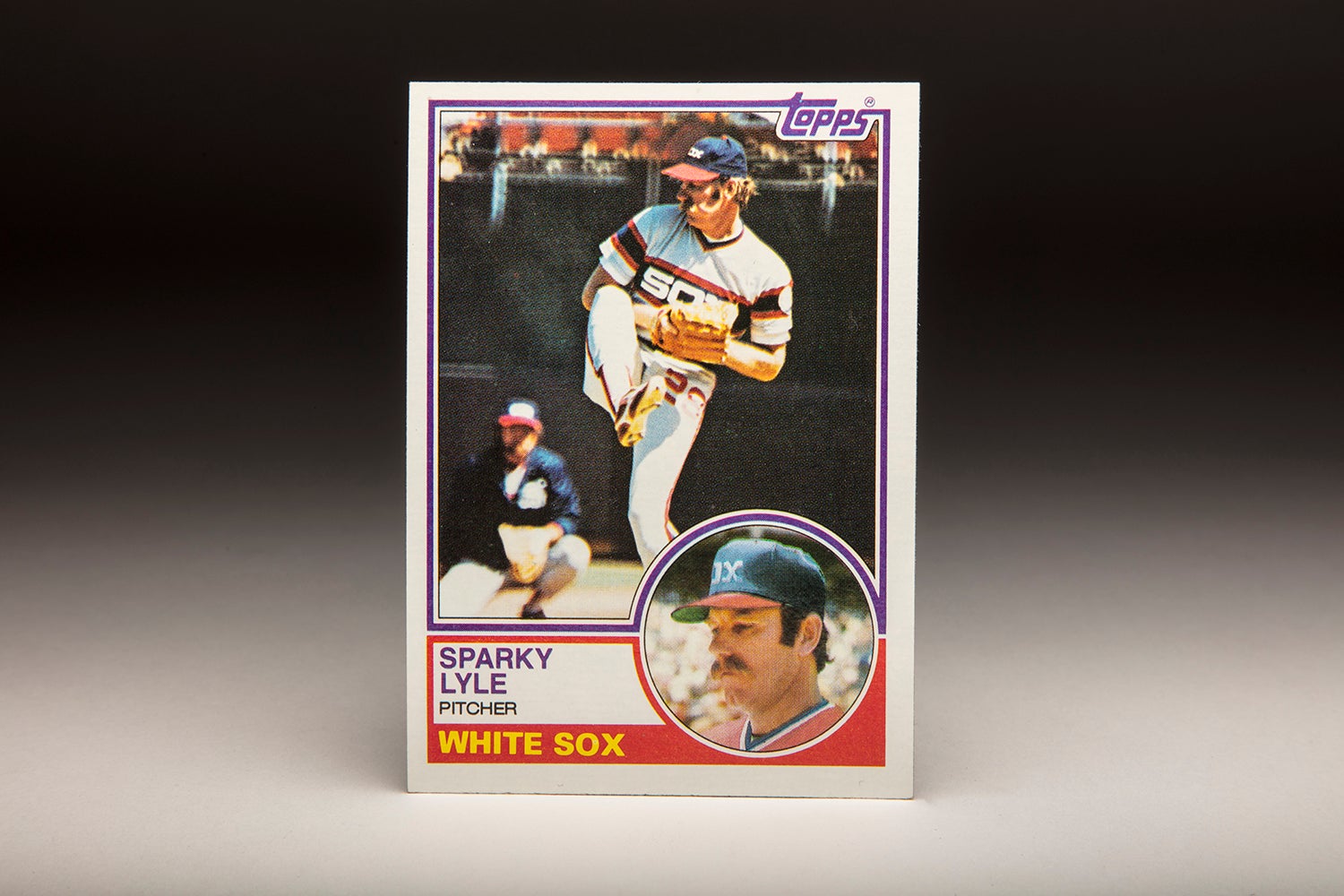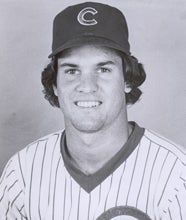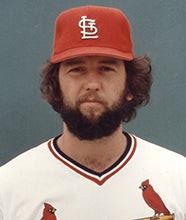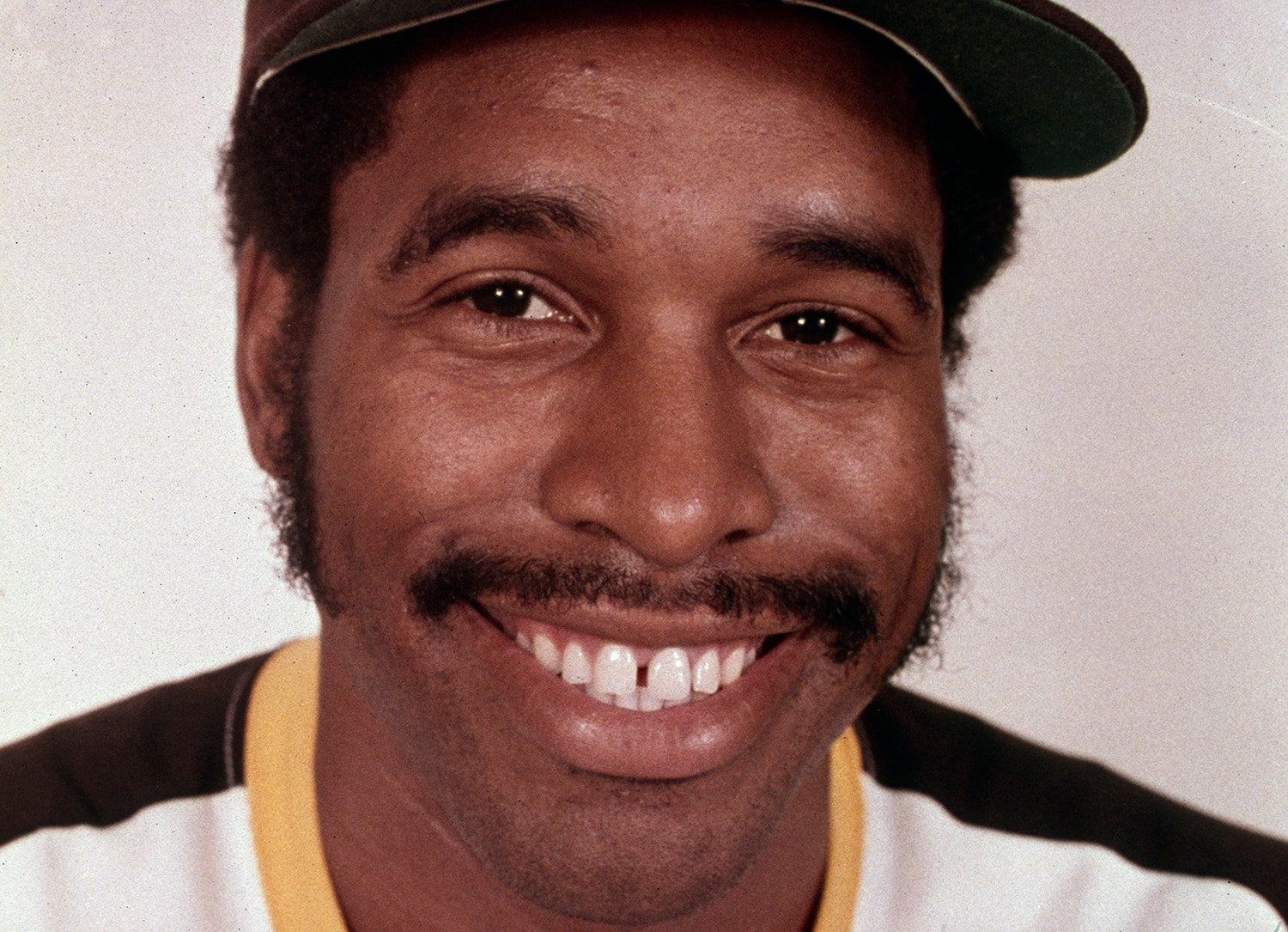- Home
- Our Stories
- #CardCorner: 1983 Topps Willie McGee
#CardCorner: 1983 Topps Willie McGee
In the days when televised World Series games made instant celebrities out of baseball heroes, Willie McGee went from a relatively anonymous big league rookie to an overnight sensation in the fall of 1982.
“I don’t know if anyone,” Cardinals manager Whitey Herzog said after the Cardinals won Game 3 of the Fall Classic on Oct. 15, 1982, “has played a better World Series game than Willie did tonight.”
For McGee, it was the start of more than a decade in the spotlight as one of the game’s top center fielders.
Born Nov. 2, 1958, in San Francisco, McGee grew up in nearby Richmond, Calif., in a working class household. A late bloomer, McGee fell in love with sports at an early age but did not shine on the diamond until his speed caught the attention of the high school baseball coach at Henry Ells High School.
“I never did much,” McGee told the San Francisco Examiner of his high school playing days. “I wasn’t anything special.”
Official Hall of Fame Merchandise
Hall of Fame Members receive 10% off and FREE standard shipping on all Hall of Fame online store purchases.
McGee did hit .393 his senior season, though – a season after his teammate, Eddie Miller, was selected in the second round of the MLB Draft by the Rangers before going on to a seven-year big league career. And McGee’s speed was enough to get him noticed by MLB scouts, leading the White Sox to select him in the seventh round of the 1976 MLB Draft. McGee, however, decided instead to enroll at Diablo Valley College in Pleasant Hill, Calif., and led the team to the state junior college championship in 1977.
In January of 1977, the Yankees selected McGee with the 15th overall pick in that month’s secondary phase draft. After fulfilling his collegiate commitment, McGee reported to Oneonta of the New York-Penn League, where he hit .236 in 65 games.
A natural right-handed batter, the Yankees encouraged McGee to switch hit to take advantage of his speed. He hit .251 with 25 stolen bases for Class A Fort Lauderdale in 1978, then split time between Fort Lauderdale and Double-A New Haven a year later, hitting a combined .289with 23 steals.
Injuries limited McGee to just 78 games with Double-A Nashville in 1980. Then following a season where the Yankees won the AL East but were swept by the Royals in the ALCS, owner George Steinbrenner signed free agent Dave Winfield to a massive 10-year, $23 million contract. Suddenly, the Yankees outfield featured future Hall of Famers like Winfield and Reggie Jackson along with veterans like Oscar Gamble, Jerry Mumphrey and Lou Piniella.
To make room for Winfield, McGee was removed from the Yankees’ 40-man roster.
“It was between McGee and one other player (to be dropped from the 40-man roster),” Bill Bergesch, the Yankees director of player personnel, told The New York Times. “We decided to outright McGee to our (Triple-A) Columbus farm team, which meant…he couldn’t be reacquired by us without going through major league waivers.”
McGee then failed to make the Columbus roster in Spring Training of 1981 and was sent back to Nashville. He hit .322 with 24 steals and 63 RBI in 100 games for the Sounds, setting the stage for a trade that would be bemoaned by Yankees fans for years.
“We knew that if we tried to get (McGee) back through waivers, we’d probably lose him for $20,000,” Bergesch said. “So we decided to trade him. That way at least we could get a player for him.”
The player the Yankees got was Cardinals pitcher Bob Sykes – in a deal that was consummated on Oct. 21, 1981. Sykes, who was 2-0 with a 4.58 ERA in 22 games in 1981, quickly developed arm problems and never pitched a game for the Yankees.
“I thank him (Steinbrenner) for giving me the opportunity to play professional baseball and to be in such a good organization,” McGee told United Press International.
But it was in St. Louis where McGee would become a star.
“We had great reports on McGee from three scouts when he was playing for Nashville in the Southern League,” Cardinals general manage and manager Whitey Herzog told the San Francisco Examiner. “He’s a worker.”
McGee began the 1982 season with Triple-A Louisville, where he was hitting .291 through 13 games when Cardinals center fielder David Green injured his hamstring in early May. The Cardinals quickly brought McGee to the majors, where he made his debut on May 10. Within two weeks, McGee was starting in center field.
The Cardinals were en route to the National League East title with a team that Herzog had reshaped into one that relied on speed and defense. McGee fit right in, hitting .331 as late as Aug. 27 before finishing with a .296 batting average, 56 RBI and 24 steals in 124 games.
At 23, McGee was entering postseason play as an unproven quantity. But he quickly dispelled all doubts by hitting .308 with four runs scored, five RBI, a triple and a home run in the Cardinals’ three-game sweep of the Braves in the NLCS. Then in the World Series, McGee grabbed the spotlight in Game 3 with the Cardinals and Brewers tied at a game apiece.
McGee made a nifty catch of a Paul Molitor drive in the bottom of the first inning, then broke a scoreless tie in the fifth with a three-run homer off Brewers ace Pete Vuckovich. McGee homered again in the seventh inning to push the Cardinals’ lead to 5-0. And with one on and one out in the bottom of the ninth and St. Louis holding a 6-2 lead, McGee robbed Gorman Thomas of what looked to be a home run, leaping at the center field wall following a blast off Cardinals relief ace Bruce Sutter.
“Well hit, way back…What a catch he made! Willie McGee! Willie McGee!” said NBC’s Joe Garagiola. “With the bat and with the glove, he’s been a one-man show tonight.”
The Cardinals won the game 6-2, and McGee made headlines throughout the country and the world the next day. He became just the third rookie to hit multiple home runs in one World Series game, joining Charlie Keller of the Yankees in 1939 and Tony Kubek of the Bronx Bombers in 1957.
“If some experts had said before the game Willie McGee was going to hit two home runs, you would have had to bet against it,” Vuckovich told UPI. “You have to give him credit.”
The series went the full seven games, with Milwaukee winning Games 4 and 5 to push the Cardinals to the brink of elimination. But McGee chipped in with a hit, run scored and RBI in St. Louis’ 13-1 win in Game 6, then scored the first run of the night in Game 7 as the Cardinals won 6-3 to capture the title.
He capped off an unforgettable freshman campaign when he finished third in the National League Rookie of the Year voting.
The Cardinals failed to repeat as NL East champions in 1983, but McGee proved that his rookie season was no fluke when he hit .286 with 75 runs scored, 75 RBI and 39 stolen bases while earning an All-Star Game berth and winning a Gold Glove Award. Following the season, McGee agreed to a three-year, $1.2 million contract.
McGee posted similar numbers in 1984, hitting .291 with 82 runs scored, 50 RBI and 43 steals. On June 23, 1984, McGee hit for the cycle against the Cubs but was overshadowed in the papers the following day after Ryne Sandberg hit home runs off Sutter in the ninth and 10th innings in what became an 11-10 Chicago victory – and a contest that would be forever known as the Sandberg Game.
Then in 1985, McGee and the Cardinals reclaimed their 1982 form and then some – winning 101 games while electrifying fans with unrelenting speed on the bases. McGee hit .353 with 216 hits and 18 triples – all tops in the NL – to go with 114 runs scored and 56 steals.
He would easily take home the NL MVP Award, earning more first-place votes than all other candidates combined. McGee also won a Gold Glove Award and a Silver Slugger Award while earning another All-Star Game berth.
“The last few years he’s gotten smarter, learned how to hit,” Herzog told the San Francisco Examiner about his star center fielder.
McGee had seven hits apiece in both the NLCS and the World Series. But after St. Louis defeated the Dodgers in the championship series – with McGee’s two-run, seventh-inning single sparking a rally in Game 6 that led to the Cardinals’ 7-5 win – the World Series would not be as pleasant.
The American League champion Kansas City Royals rallied from a 3-games-to-1 deficit to defeat the Cardinals, with McGee going hitless in the final two games.
Hamstring and knee injuries limited McGee to 124 games in 1986, and McGee posted career lows of 48 RBI and 19 steals while hitting just .256. He did, however, win his third-and-final Gold Glove for his play in center field.
But in 1987 – following offseason surgery on his left knee and a contentious trip through the arbitration process – McGee revved up the Cardinals’ offense once again, hitting .285 with 37 doubles, 11 triples, 11 home runs and 105 RBI as St. Louis won its third NL East title in six seasons. McGee hit .308 and drove in what proved to be the winning run in Game 7 in the Cardinals’ win over the Giants in the NLCS. He was even better in the World Series, hitting .370 with 10 hits in 27 at-bats against the Twins. But Minnesota won the Fall Classic in seven games, with McGee grounding out to third base to end the Twins’ 4-2 win in the deciding game.
“We showed a lot by the way we played the season,” McGee told the Fort Worth Star-Telegram after Game 7. “One game, and we’re the best team in the world.”
In January of 1988, McGee and the Cardinals avoided arbitration when they agreed on a three-year, $4.1 million deal. He hit .292 that year with 41 steals and 50 RBI, earning his fourth-and-final All-Star Game berth. But in 1989, McGee was saddled with hamstring and wrist injuries that limited him to 58 games and a .236 batting average.
He bounced back in 1990 with a strong first half that saw him hitting .335 – second in the National League, five points behind Philadelphia’s Lenny Dykstra – on the morning of Aug. 29. But with top prospect Ray Lankford having debuted the week before and McGee’s contract expiring, the Cardinals traded him to the Oakland Athletics in exchange for Felix Jose, Daryl Green and Stan Royer.
“I’m happy because I’m going home,” McGee told the St. Louis Post-Dispatch. “It really couldn’t be a better situation. (But) I’m sad to be leaving an organization that I’ve built part of my life around.”
McGee hit .274 in 29 games with the A’s, helping Oakland win its third straight AL West title. McGee hit .222 as the Athletics swept Boston in the ALCS and was 2-for-10 in four games as the Reds shocked the A’s by winning the World Series in four straight.
McGee, however, claimed a consolation prize when he won his second NL batting title. His 542 plate appearances with the Cardinals were enough to qualify for the NL crown – and McGee finished five points ahead of runner-up Eddie Murray of the Dodgers and 10 points ahead of Dykstra.
Now a free agent, McGee signed a four-year, $13 million contract with the Giants on Dec. 3 to stay close to his Bay Area home. He replaced Brett Butler in center field for the Giants when Butler and the team could not agree on a new contract.
“Willie wanted to play in the Bay Area, but there were no expectations because the Giants and A’s both had outstanding center fielders,” McGee’s agent Tom Reich told McClatchy News Service, noting that the A’s had committed to Dave Henderson as their center fielder for 1991. “It couldn’t have turned out any better for Willie.”
McGee was a consistent presence in the outfield for the Giants for the next three seasons, hitting between .297 and .312 and playing in about 130 games a year. He moved to right field full time in 1993, helping San Francisco win 103 games in a season where they Giants fell one game short of the Braves for the NL West title.
But McGee’s time with the Giants effectively came to an end on June 7, 1994, when he crashed into the outfield wall at Pittsburgh’s Three Rivers Stadium while chasing what became a triple hit by the Pirates’ Orlando Merced. McGee tore his left Achilles tendon on the play and was lost for the season, finishing the year with a .282 batting average in 45 games.
When MLB returned from a strike in the spring of 1995, McGee was without a contract. He hooked on with the Red Sox on a minor league deal on June 6 and made it back to the big leagues a month later, playing regularly during the season’s final three months while hitting .285 in 67 games.
Then on Dec. 15, McGee returned to St. Louis on a minor league deal with the expectation he would be a reserve outfielder. For the next four seasons, McGee contributed regularly off the bench, hitting .307 in 1996 and .300 a year later before winding down with averages of .253 in 1998 and .251 in 1999. He helped the Cardinals advance to the NLCS in 1996, hitting .333 in St. Louis’ seven-game loss to the Braves.
On Nov. 21, 1999, McGee confirmed to a TV crew at his home in the Bay Area that he was going to retire.
“I’ve been thinking about it for four years,” McGee told the Post-Dispatch. “Sooner or later, this day was coming. It’s (the desire to play) not in my heart. I don’t think it can be there again.”
But despite maintaining his home in the Bay Area, St. Louis was never far from McGee’s orbit. He joined the Cardinals as a coach in 2018 and remained a fan-favorite for years after his retirement.
In 18 big league seasons, McGee totaled 2,254 hits, 352 stolen bases, 1,010 runs scored and 856 RBI. He finished with a .295 batting average, one point shy of the mark he set as a rookie sensation in 1982.
“My quiet nature makes me what I am. I’m just being me,” McGee told the Sacramento Bee. “I’m a ballplayer. That’s what I am.”
Craig Muder is the director of communications for the National Baseball Hall of Fame and Museum

